For generations, flowers have represented affection, love, and beauty. They are employed to communicate ideas and feelings that words sometimes are unable to.
And when it comes to flowers that begin with the letter F, we have an abundance of options. There are countless alternatives, from the delicate and fragrant Freesia to the regal and elegant French Marigold.
Flowers with the letter F come in a variety of forms, hues, and sizes, and each one has its own narrative to share. You should continue reading if you enjoy the beauty of flowers, are an avid gardener, or simply love the outdoors.
We’ll examine some of the most stunning and significant flowers that begin with the letter F in this guide, as well as what makes each one so unique.
Keep Reading:
- Flowers That Start With A
- Flowers That Start With B
- Flowers That Start With C
- Flowers That Start With D
- Flowers That Start With E
List Of Flowers That Start With F
1. Fumewort (Corydalis solida)
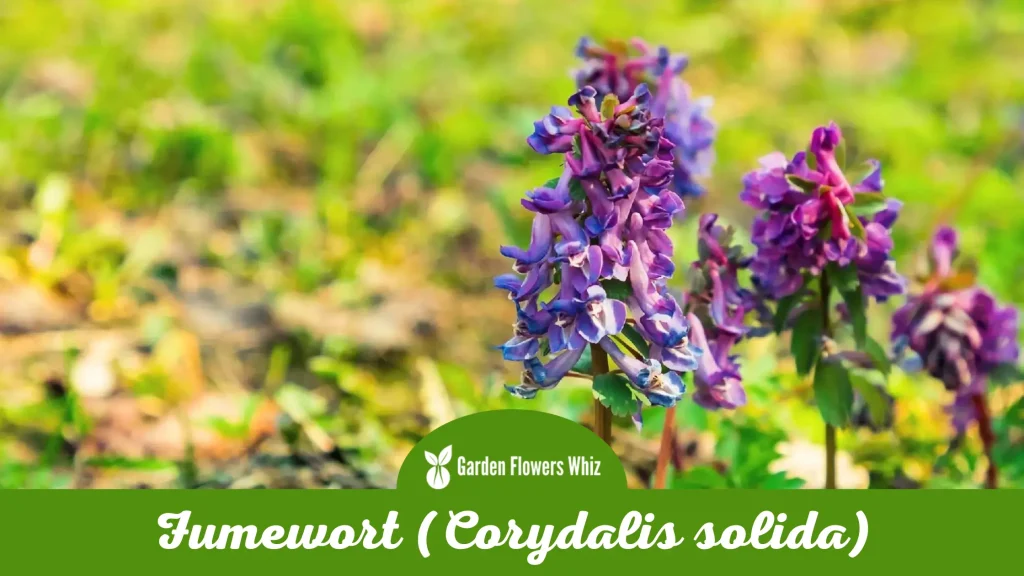
The poppy family includes the little perennial herbaceous plant known as fumewort or Corydalis solida. It is indigenous to Europe and blooms in the spring.
The plant bears tiny, delicate blooms that are often pink or purple in color and are placed in clusters on long, slender stalks.
The blooms have four petals that are slightly asymmetrical and form an unusual heart shape. The plant’s foliage is equally lovely, with fern-like leaves that are light green and finely split.
Fumewort thrives in moist, well-drained soil and moderate shade, making it a perfect plant for woodland gardens or gloomy borders.
Very well-liked for rock gardens, fumewort can also be cultivated in containers. It is a well-liked addition to any garden because of its reputation for being delicate beauty.
2. Fuschia
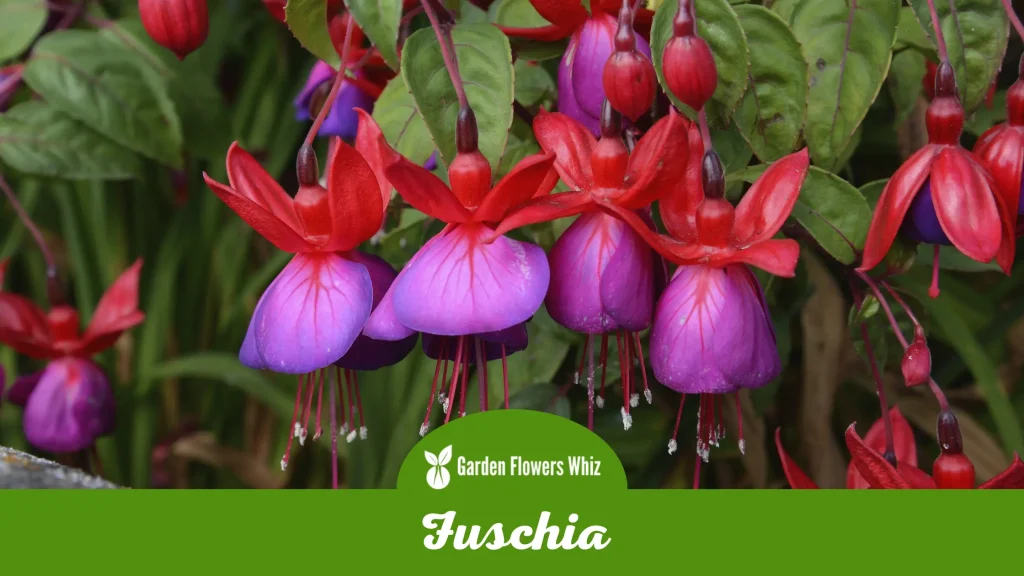
The gorgeous flowering plant fuchsia is a member of the Onagraceae family. It is indigenous to Central and South America and bears Leonard Fuchs’ name, a distinguished botanist.
There are many colors of fuchsia plants, including red, purple, pink, and white. The bell-shaped flowers can bloom all through the summer and fall, adding beauty to gardens or potted plants.
The Fuchsia plant has glossy leaves that are typically oval in form. From ancient times, fuchsia flowers have been grown in gardens and as indoor plants because of their lovely beauty.
They are well-liked by gardeners for their adaptability to varied growing environments and versatility. To thrive, fuchsia plants need regular watering, well-draining soil, and moderate sunlight.
These plants can be raised as climbers, shrubs, or as hanging baskets. Fuchsia flowers are a wonderful addition to any garden because they draw hummingbirds and other pollinators.
3. Frikart’s Aster
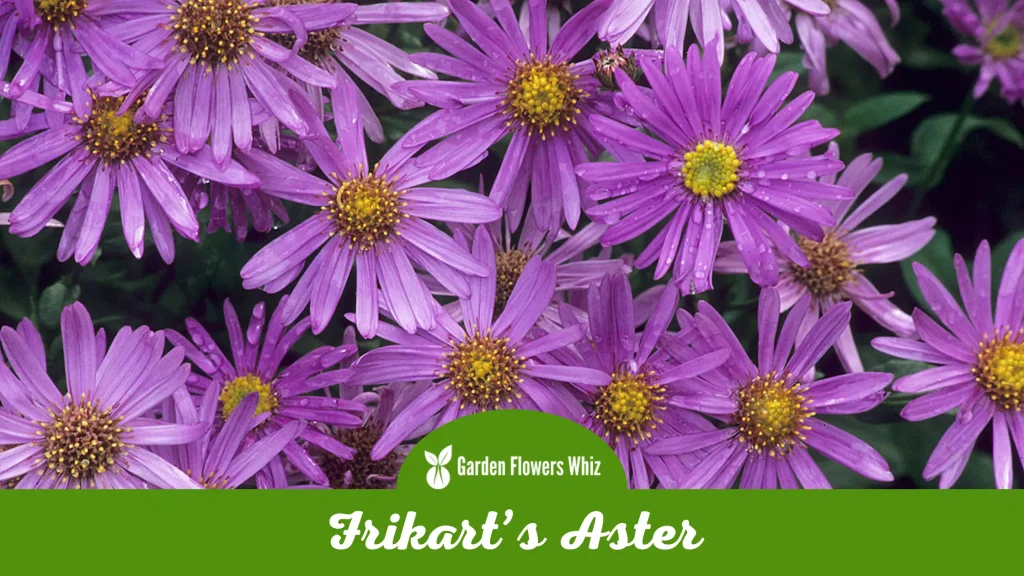
Aster x frikartii, often known as Frikart’s Aster, is a well-known herbaceous perennial that is a member of the Asteraceae family. It is a cross of two aster species, and it produces a lot of daisy-like flowers that are various shades of purple, from light lilac to deep.
The plant enjoys full sun to partial shade with well-draining soil and is native to the mountainous regions of Europe. It clumps and reaches a height and width of around 2-3 feet.
The lance-shaped, green foliage grows into a compact mass that resembles a tidy mound. It is the ideal addition to any garden since the flowers bloom in late summer and early fall and draw a variety of pollinators, including bees, butterflies, and hummingbirds.
Frikart’s Aster requires little maintenance and can be pruned after the first bloom to promote a second flush of blooms.
4. French Marigold

The annual flowering plant known as the French marigold, or Tagetes patula, is prized for its vivid and striking blossoms. The plant is widely cultivated worldwide and is native to Mexico and Central America.
French marigolds are a common choice for gardeners of all skill levels because they are simple to grow and require little maintenance.
The plant produces little, compact flowers with orange, yellow, and red hues, and they usually have a diameter of around 2 inches.
French marigolds are employed in companion planting to ward off pests since they are believed to have natural insect-repelling qualities in addition to their decorative appeal.
French marigolds are beautiful and adaptable plants that may be used in borders, containers, and other settings. They are sure to provide color to any garden.
5. Freesia
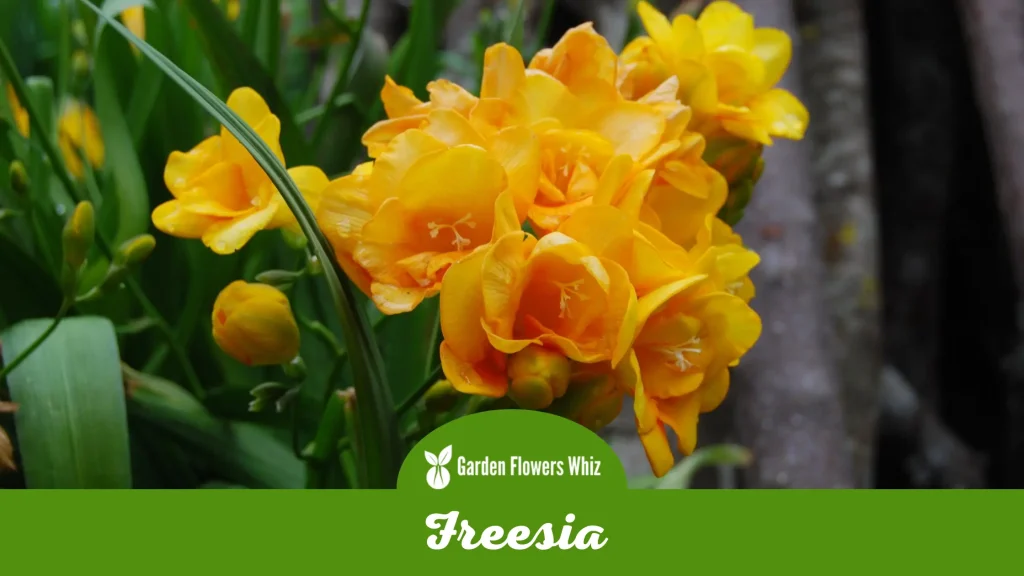
The Iridaceae family includes the lovely and fragrant freesia flower. Because of its delicate and sweet aroma, this flower, which is native to South Africa, has long been a favorite.
Freesias are funnel-shaped, six-petaled flowers that come in a variety of brilliant colors, including white, yellow, pink, red, purple, and blue. They are plants that grow on thin stems.
The blooms have unusually textured petals that are slightly curled. Freesias are frequently used in fragrances, soaps, and candles because of their pleasant, lemony fragrance.
Due to their persistent blooms and fragrant scent, freesias are frequently used as cut flowers and in floral arrangements.
Whether in a garden or in containers, freesias bloom throughout the spring and summer. For them to flourish, the soil must have good drainage and receive enough sunlight.
In addition to being lovely, freesias also stand for innocence, purity, and friendship, making them the ideal present for someone special.
6. Frangipani

The stunning tropical flower frangipani is indigenous to South America, the Caribbean, and Central America. The flower is a preferred ingredient for fragrances and scented candles due to its sweet and intoxicating aroma.
The scientific name for the frangipani is Plumeria, and it belongs to the Apocynaceae family. It features five spiral-shaped petals in a variety of hues, including white, yellow, pink, and red, and has five petals.
This flower is a great option for gardens and landscaping because it blooms in the summer and can reach a height of 20 feet.
Beautiful and significant in many cultures and religions, frangipani is a worldwide favorite. In Hawaii, where it is called “Melia,” it is used to make leis.
The flower is linked to love and devotion in certain cultures, while prosperity and good fortune are thought to be brought by it in others.
A magnificent flower known for its beauty, scent, and cultural significance is the frangipani.
7. Foxglove

Foxglove, often referred to as Digitalis, is a stunning and well-known flower that is indigenous to Europe and some regions of Asia.
It is a well-liked option for gardens and floral arrangements thanks to its unusual bell-shaped blossoms, which are frequently seen in colors pink, purple, and white.
When handling the plant, caution is suggested because it can be quite hazardous if consumed in big quantities.
The foxglove has been utilized in literature and folklore in addition to medicine, and its bell-shaped blossoms are frequently connected to fairies and other supernatural beings.
8. Four O’clock
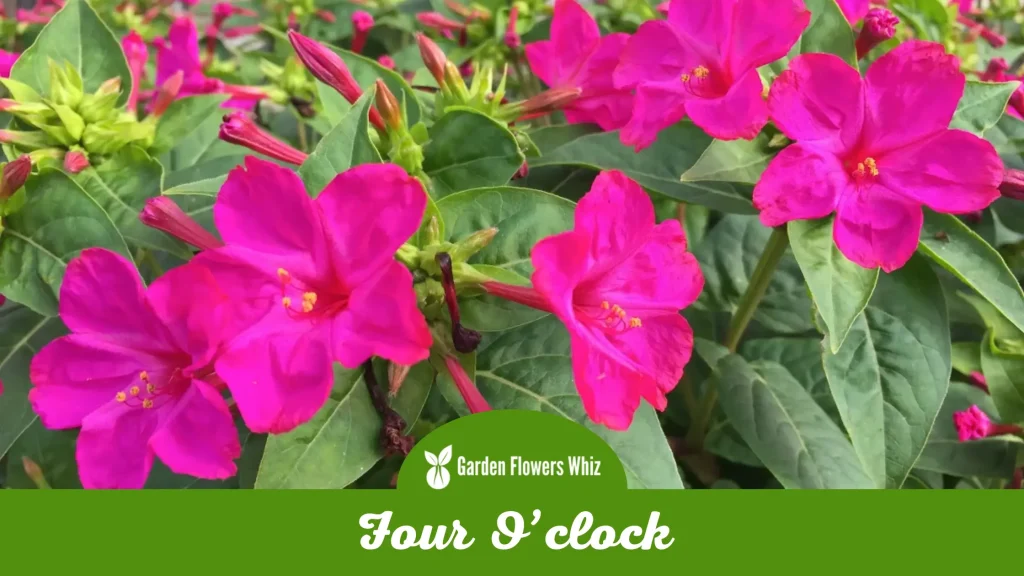
The name “Four O’Clock” comes from a lovely and fragrant flower with the name Mirabilis jalapa, which blooms in the late afternoon. Although of South American origin, this flower has been widely cultivated throughout the world.
Pink, crimson, yellow, white, and magenta are just a few of the many colors that the blossoms may be found in. They can have single or multiple blooms and resemble a trumpet.
The robust stems of the four o’clock grow to a height of two to three feet. A lovely smell fills the air at night as the plant blooms throughout the summer and fall.
The plant is simple to cultivate, needs little maintenance, and is a great choice for novice gardeners.
9. Forsythia
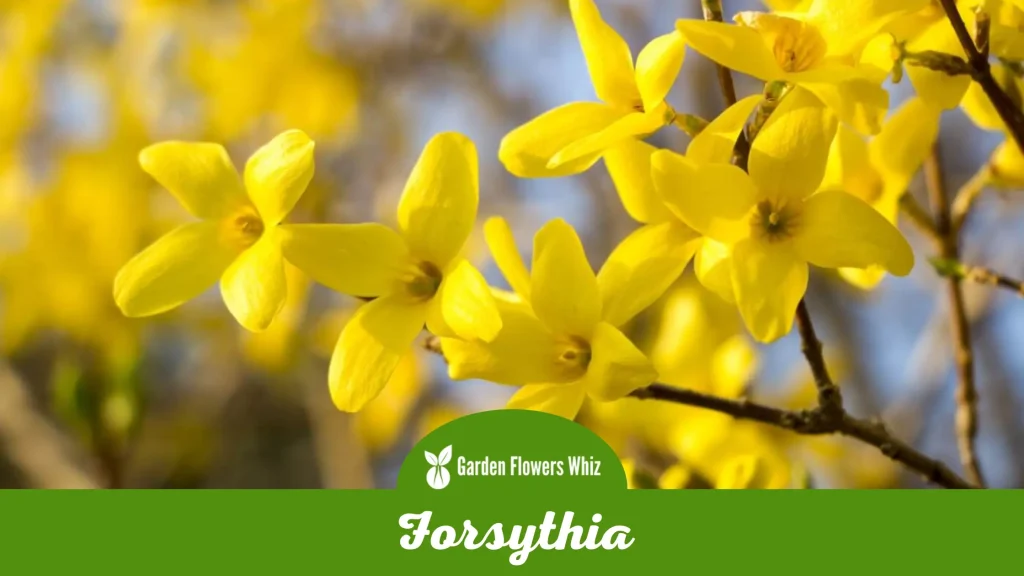
A genus of deciduous flowering shrubs in the Oleaceae family of olives is called Forsythia. The plant is frequently cultivated for its decorative value in gardens and landscapes and is native to East Asia, particularly in China and Korea.
The shrub normally produces an abundance of bell-shaped yellow flowers in bunches along its branches in the early spring before its leaves emerge.
Forsythia blooms are a common emblem of optimism and rejuvenation and an early sign of spring. The plant can grow up to 3 meters tall and prefers well-drained soil, full sun, or moderate shade.
Forsythia is a great plant for beginners because it’s reasonably simple to maintain and requires little work.
10. Forget Me Not
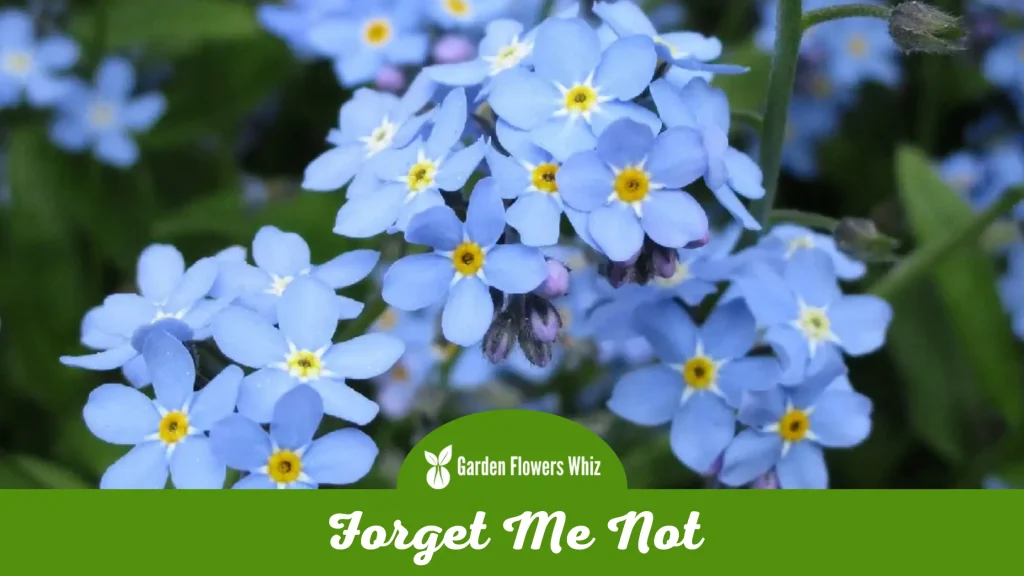
The lovely and fragile forget-me-not flower can be found in a variety of hues, such as blue, pink, white, and purple. These tiny, delicate blossoms have gained popularity as a flower to give as a gift or to plant in honor of loved ones. They are frequently cultivated in rock gardens, borders, and containers.
Because forget-me-nots are frequently connected to the concept of remembering, they are a well-liked emblem for honoring loved ones or significant occasions.
Even wedding bouquets and centerpieces can utilize to add a dash of color and texture. Not only are forget-me-nots beautiful and symbolic, but they are also a useful addition to any garden since they draw bees and other pollinators, which can benefit the local ecosystem.
Forget-me-nots are lovely and significant flowers that can lend a touch of charm and elegance to any landscape with their fragile blooms and cheery colors.
11. Floss Flower
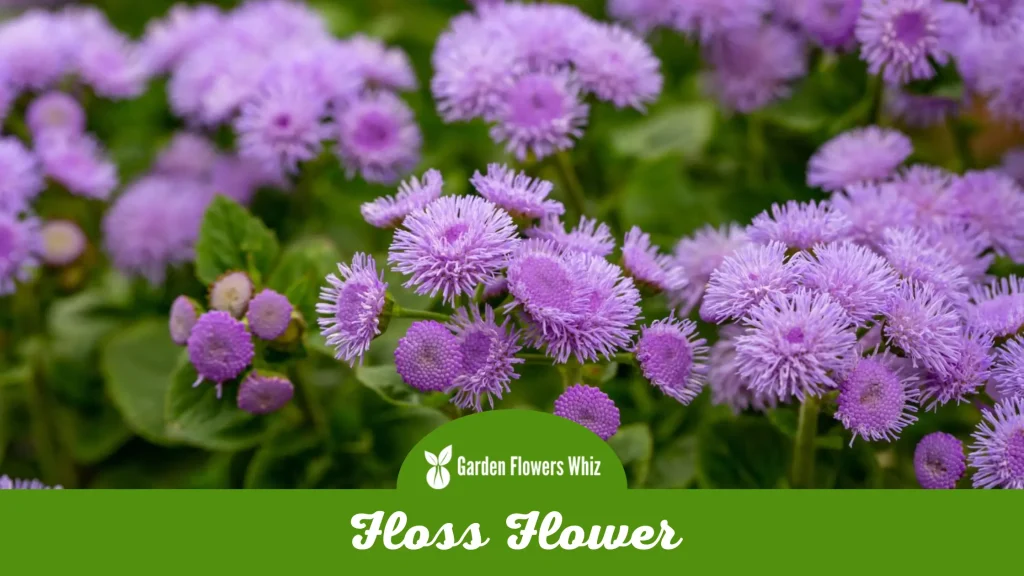
Ageratum, often known as floss flower, is a pretty annual plant in the Asteraceae family. The floss flower, which is indigenous to Central America and Mexico, has gained popularity as a garden flower throughout the world.
It is popular among beginning gardeners since it is simple to grow and needs little maintenance. The plant is distinguished by its clusters of tiny, fluffy, button-like blooms.
A variety of hues, including blue, pink, purple, and white, are offered for the blooms. A floss flower is a great option for garden beds, borders, and containers because of its lengthy flowering season, which lasts from early summer until the first frost.
In addition to its decorative appeal, the floss flower is a wonderful addition to any pollinator garden because it is known to draw helpful insects like butterflies and bees.
12. Flax Flower
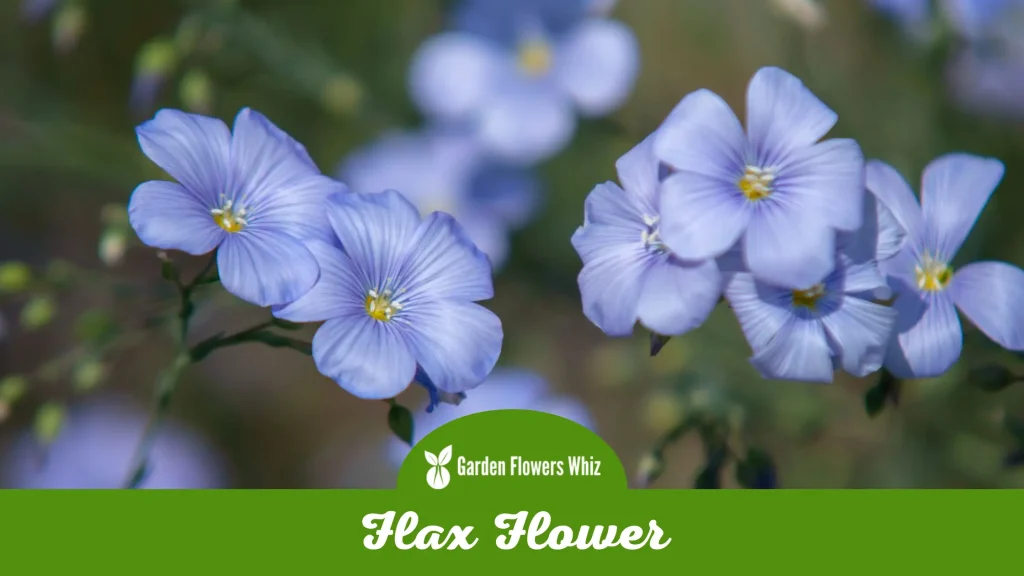
A lovely blue-flowered plant with European and Asian origins, the flax flower is sometimes referred to as common flax or linseed.
Delicate blue petals that create a cluster at the stem’s apex are produced when the blooms bloom in the summer. The plant itself is recognized for its thin, upright growth style and can grow up to three feet tall.
The flax plant is also farmed for its fiber and oil, which have been used for thousands of years for a range of things, including creating linen cloth and treating a number of medical issues.
Omega-3 fatty acids, which are crucial for sustaining good health, are abundant in the oil made from flax seeds.
13. Flannel Flower
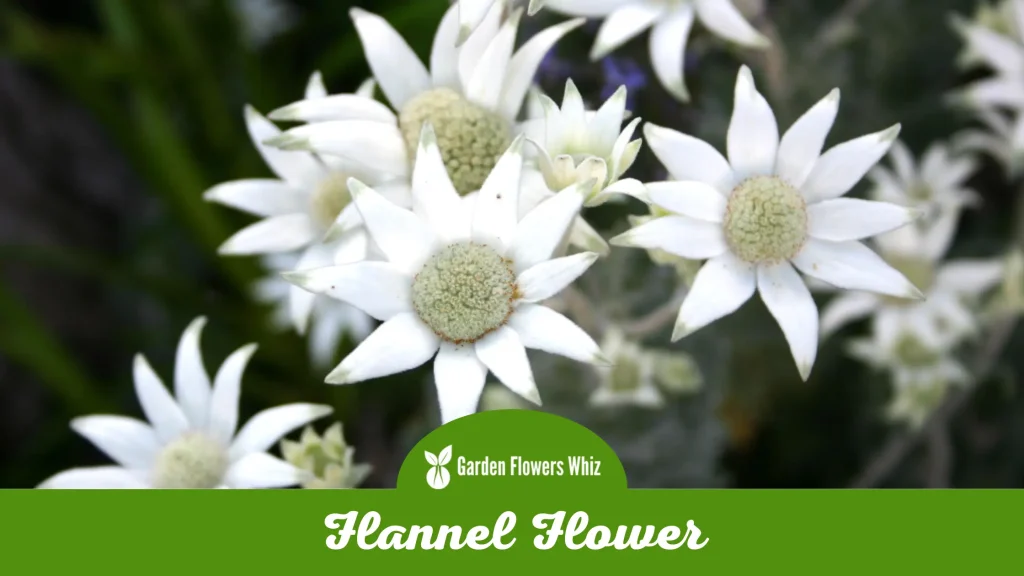
The Apiaceae family includes the lovely and delicate Australian wildflower known as the flannel flower (Actinotus helianthi). The plant’s soft, fluffy appearance, which resembles a piece of flannel, gave rise to its common name.
The petite blooms have an unusual texture due to their composition of clusters of delicate white florets encircled by thick, velvety bracts.
Native to coastal areas of eastern Australia, flannel flowers flourish in sandy soils, heathlands, and forests.
A well-liked ornamental plant, flannel flowers are a choice for cut flower bouquets due to their distinctive appearance.
The plant also holds cultural significance for Australia’s Aboriginal people, who have utilized it in their rituals and as a food source.
The flannel flower is a renowned emblem of the Australian environment because of its delicate beauty and significance to the culture.
14. Flame Nettle
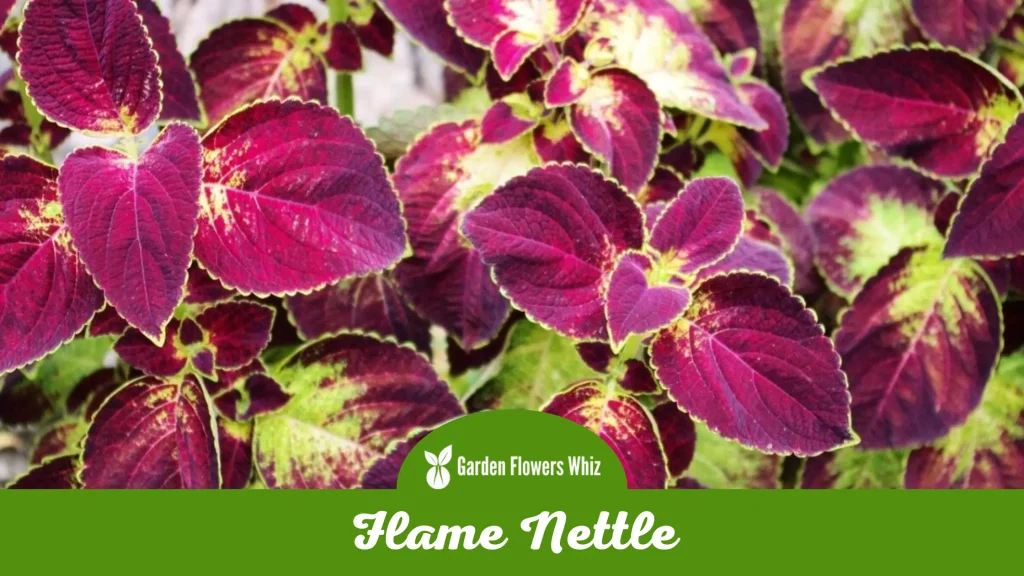
Flaming nettle, often referred to as Painted nettle or Coleus, is a common decorative plant with eye-catching vibrant leaves. Flame Nettle is a tropical perennial that is grown as an annual in cooler climes. It is native to Southeast Asia and portions of Africa.
Typically, the plant is grown for its exquisite foliage, which has a wide range of colors and patterns. The leaves may be splashed or covered in contrasting colors, and they may be green, red, pink, purple, yellow, or any combination of these colors.
Gardeners who want to add a splash of color to their outdoor environments frequently choose the fast-growing, low-maintenance Flame Nettle.
The plant needs well-draining soil and does well in either full sun or light shade. It can grow up to 2-3 feet tall and is resistant to heat and dryness.
Flame Nettle may be easily propagated from cuttings and is frequently cultivated in containers, borders, or as an indoor plant.
15. Fivespot
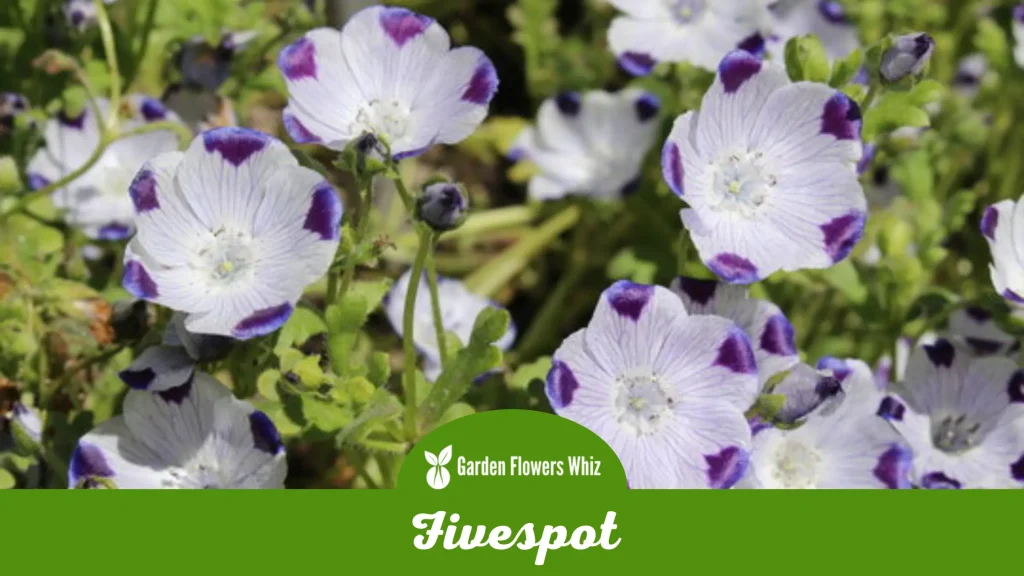
California, USA, is home to the fragile annual wildflower known as the five spots (Nemophila maculata). The flower’s name is derived from the unusual five-pointed star pattern on its petals.
Fivespot is a low-growing plant that normally blooms in the spring and summer. It barely grows to a height of 6–12 inches.
The blooms are tiny, just an inch in diameter, and come in hues of white, blue, and lavender. Each blossom has five distinctive dots in the center.
Because of its low maintenance requirements and endearing appearance, Fivespot is a popular choice for rock gardens and wildflower gardens.
It grows best in regions with dappled sunshine since it prefers soil that drains well and some shade. The plant reproduces easily and frequently self-sows in a garden, giving the area a naturalized appearance.
Because of its appeal to bees and other pollinators, Fivespot is a common option for pollinator gardens.
16. Firecracker Flower
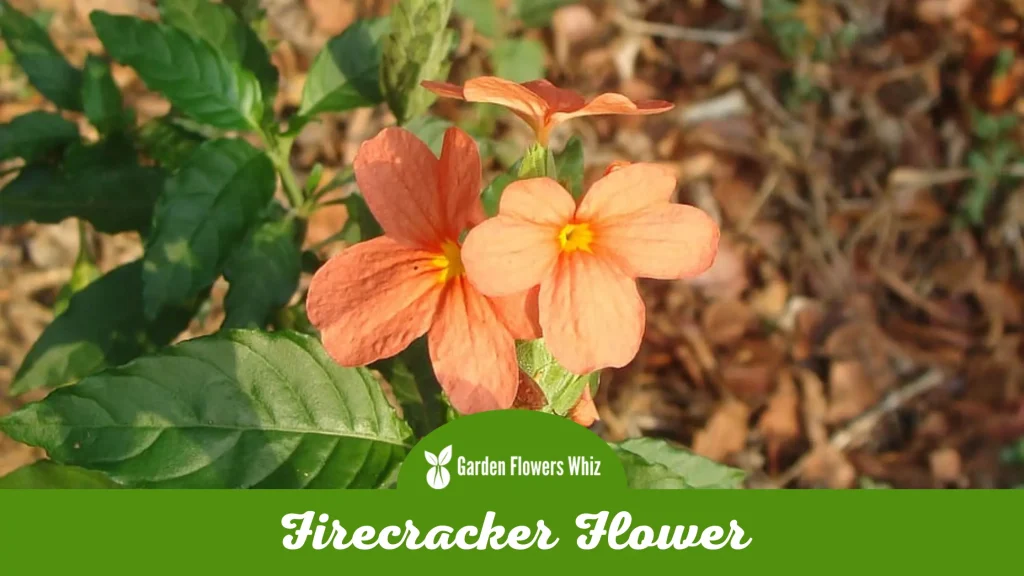
Native to Sri Lanka and India, the firecracker flower (Crossandra infundibuliformis) is a stunning tropical plant. The flower’s fiery orange or coral-red tubular blooms, which resemble an explosion of firecrackers, are what gave it its name.
Several additional names for the plant include Crossandra, Orange Marmalade, and Tropic Flame. The plant adds beauty to any garden or house with its glossy, dark green leaves and vivid blossoms.
A common ornamental plant that thrives in warm, humid regions is the firecracker flower. It is a plant that requires little upkeep and can withstand some neglect, making it a wonderful option for those who don’t have a lot of free time for gardening.
A perennial with up to three feet of height, firecracker flowers bloom from April through fall. It is a great choice for garden borders, container gardening, or as a houseplant because it prefers well-draining soil and exposure to moderate to full light.
17. Fire Pink
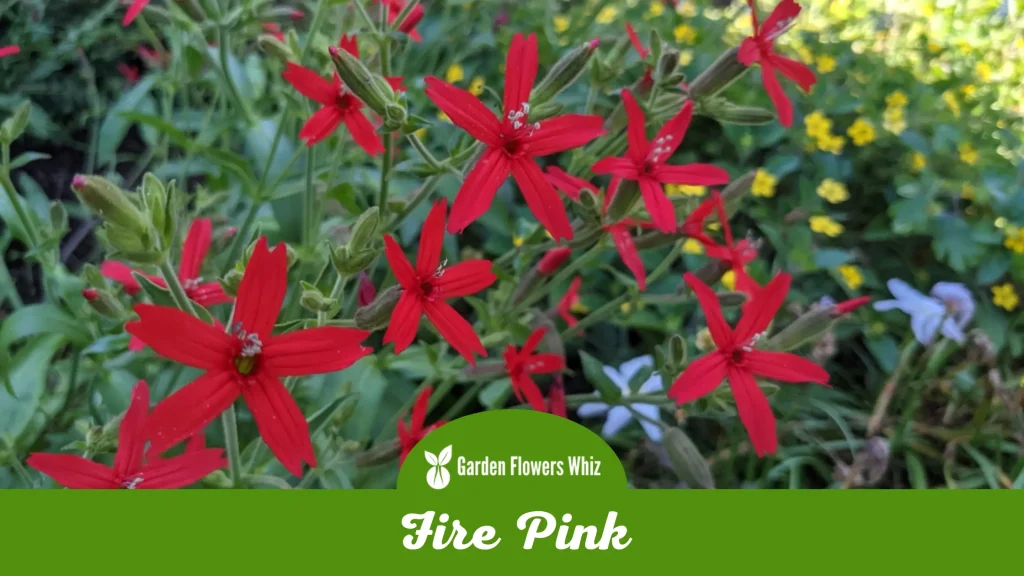
Native to North America, fire pink, also known as silene virginica, can be found in open woods, on rocky outcroppings, and along the edges of fields.
The plant’s brilliant red or pink blossoms, which bloom in the early summer and draw hummingbirds and butterflies, gave rise to its name.
The blooms are tiny, have five petals, and are tubular in shape. At the base of the stem, a rosette of long, narrow leaves with a bluish hue grows.
In gardens, fire pink, a perennial with a limited lifespan, is frequently planted as an annual. It is simple to grow and prospers in soil that drains well, with full sun to partial shade and a modest amount of rainfall.
It makes a wonderful addition to borders, rock gardens, or naturalized areas as a wildflower. It is now mostly valued for its decorative qualities and is a favorite of both gardeners and nature lovers.
18. Feverfew
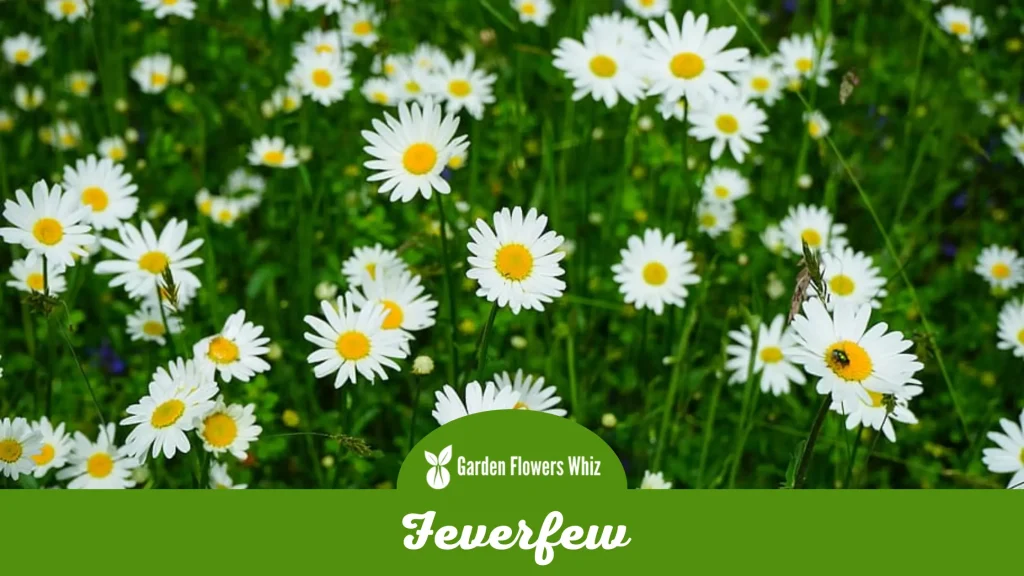
The tiny, bushy perennial herb known as feverfew, also referred to as wild chamomile, originates originally from southern Europe but has since been spread to other regions of the world, including North America.
The yellow-green leaves of the feverfew plant are covered in daisy-like flowers, which bloom from early summer until late fall.
Since the blossoms have a distinctive perfume, aromatherapy practitioners frequently utilize them to ease stress and anxiety. Feverfew is a relatively simple plant to grow and is frequently grown in gardens for its therapeutic benefits as well as its lovely foliage and vibrant flowers.
Although it can take some shade, it loves full sun and soil that drains well. Feverfew might have adverse effects, so it’s crucial to keep that in mind when using it. It is recommended to seek medical advice before using feverfew, as with any therapeutic plant.
19. Fern Leaf Yarrow
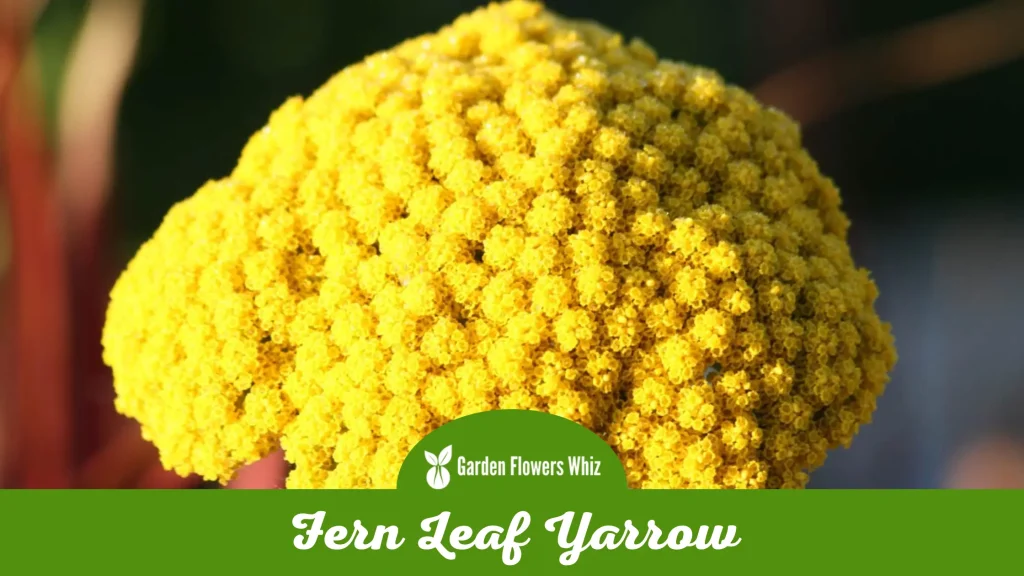
A perennial plant with a natural range in temperate regions of Asia and Europe, Fern Leaf Yarrow is also known as Achillea filipendulina or Golden Yarrow.
While in bloom from late spring to early fall, this plant, which may grow up to 3 feet tall, bears flat-topped clusters of small, daisy-like flowers with vivid yellow petals.
The fluffy, fern-like leaves of the Fern Leaf Yarrow enhance a garden’s richness and contrast.
A hardy plant that requires little care and is resistant to heat, drought, and pests is the fern leaf yarrow. It thrives in full sun and well-drained soil, making rock gardens, borders, and meadows a wonderful place to include it.
The stunning and adaptable Fern Leaf Yarrow is a plant that will enhance any garden or landscape with color, texture, and interest.
20. Fan Flower
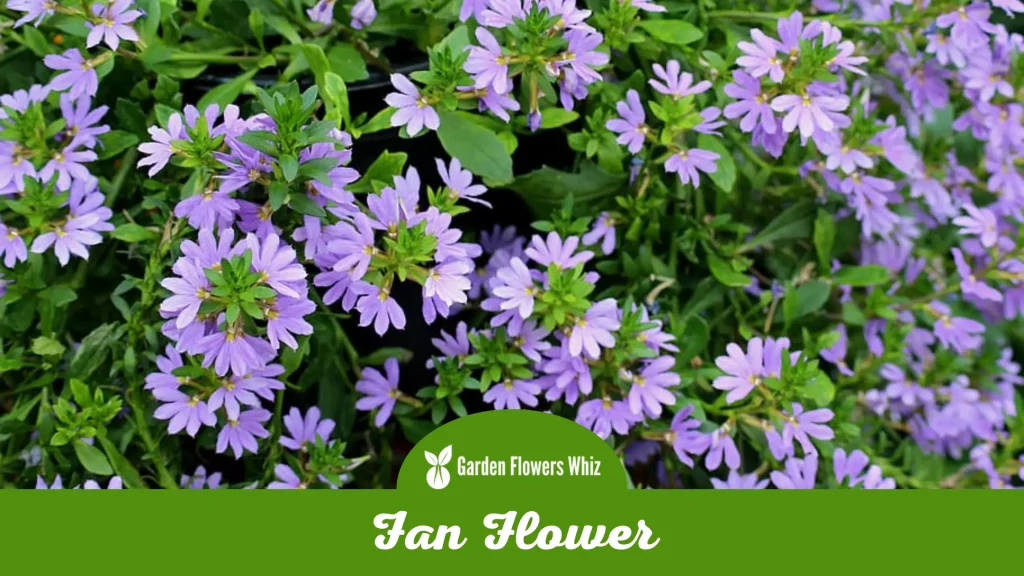
Australian-native fan flower, scientifically known as Scaevola aemula, is a stunning flowering plant. It is frequently referred to as the fairy fan flower or the Australian fan flower and is a member of the Goodeniaceae family.
Fan flower plants can reach heights of 20 to 30 cm and a spread of 40 to 50 cm. The fan flower has fleshy, oval-shaped leaves that have a vibrant green color.
The fan flower’s blossoms, which bloom in a variety of hues including blue, white, pink, and purple, are the main draw. Gardeners and flower lovers adore the fan-shaped blossoms for their distinctive charm.
With full light and soil that drains properly, fan flowers flourish. Both seasoned and inexperienced gardeners favor them since they are simple to care for and need little maintenance.
In landscaping, the fan flower can be used as a ground cover, a border plant, and in container gardens. It draws bees, butterflies, and other pollinators, making it a great option for gardeners hoping to build a thriving environment.
21. False Rue Anemone

Eastern North America is home to the fragile perennial wildflower known as False Rue Anemone, or Enemion biternatum. It often grows in deciduous forests and woodland margins, and in the early spring, before the trees have fully leafed out, it produces lovely white blooms.
The plant’s stems bear one or two leaves and a single terminal bloom, while the basal leaves are highly lobed and serrated.
The flowers themselves resemble feathers due to their many stamens and six to eight petals.
False Rue Anemone, despite its name, is more closely related to Buttercups than it is to true Anemones. As long as it is provided a moist, shady position, it is a simple plant to grow in the garden.
It adds something useful to rock gardens, woodland gardens, and other realistic environments. The False Rue Anemone is a crucial plant for native pollinators as well, including bees and butterflies, who rely on its early-season nectar and pollen as a crucial source of nourishment after the winter.
22. False Indigo
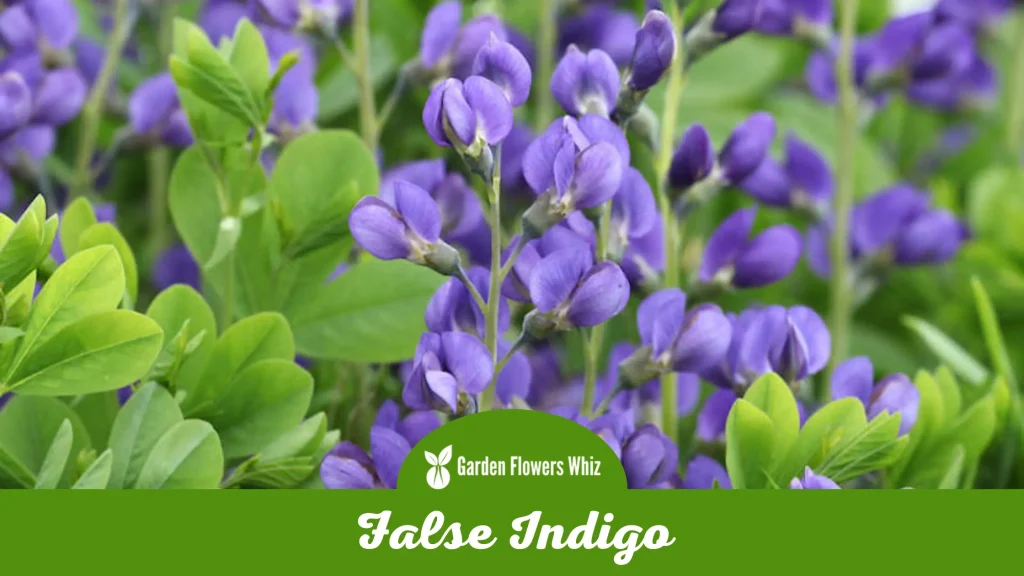
A perennial herbaceous plant native to North America, false indigo is also known by the scientific name Baptisia australis. It belongs to the pea family and blooms in late spring to early summer with eye-catching spikes of blue, purple, or white flowers.
The tall, strong stems are covered in elongated clusters of pea-shaped flowers. Fake indigo is a resilient plant that thrives in a variety of soil types, is drought-tolerant, and is a favorite among gardeners and landscapers.
Recent studies have revealed that False Indigo may have the potential as a treatment for some types of cancer. The plant’s roots contain substances that have been demonstrated to have anti-inflammatory and antibacterial properties.
Fake indigo is an important plant for supporting and attracting native pollinators like bees and butterflies, as well as other helpful insects like predatory wasps and flies.
It is a native plant that has adapted well to the regional ecosystems, making it a crucial part of efforts to conserve biodiversity.
23. Fairy Duster
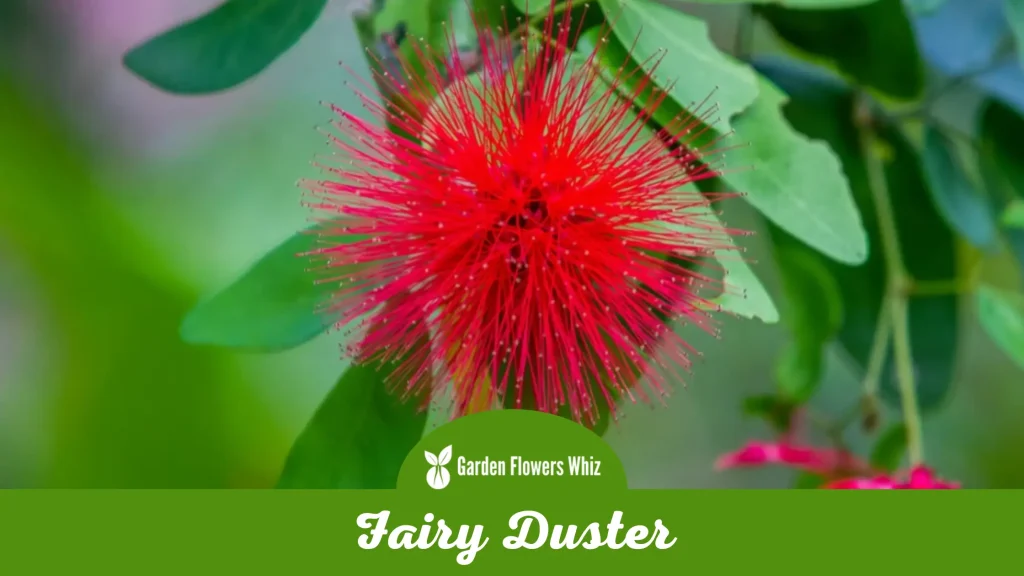
Calliandra eriophylla, often known as Fairy Duster, is a stunning and resilient perennial shrub that is indigenous to Mexico and the Southwest of the United States.
It is a plant that belongs to the legume family and gets its name from the clusters of vivid pink or red flowers that resemble fairy dust.
The plant’s fern-like silvery-grey foliage makes a lovely contrast to the flower’s colorful, spectacular blossoms. A drought-tolerant plant that does well in hot, dry climates, Fairy Duster, is a great option for xeriscape gardens and landscapes.
Fairy Duster is a crucial plant for wildlife conservation in addition to being beautiful. Many pollinators, including bees, butterflies, and hummingbirds, are drawn to its nectar-rich blossoms.
Birds, rodents, and insects are just a few of the local animals that benefit from the plant’s seeds and foliage, which also serve as food and habitat.
In Summary
F-letter flowers are more than just gorgeous blooms—they serve as a reminder of how broad and diverse nature is. Each flower has a distinct beauty that the world can enjoy while also representing many emotions and telling its own tale.
Flowers that begin with the letter F have something to offer everyone, from the delicate and exquisite Freesia to the magnificent and regal Foxglove.

Stacey Hernandez is a seasoned botanist with over 16 years of experience in the field. Her passion for plants and their intricate workings began at a young age, and she has since devoted her life to studying and understanding them.
Stacey’s expertise extends to a wide range of plant species, from delicate flowers to towering trees. As the founder of Garden Flowers Whiz, Stacey has created a platform for plant enthusiasts to seek guidance and advice.
Her website is a go-to resource for those seeking answers to their gardening dilemmas, whether it’s how to care for a particular plant or which species to choose for a specific climate.
